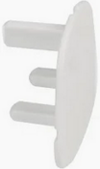I looked at the drier and washing machine in my own house, both in the Utility room, so I selected two sockets to extend from with a fused connection unit, so neither would be overloaded, but when I looked at the ratings, there was really no need.
My drier uses around 600 watt (measured with a plug in energy meter) and washing machine peaks at around 2.2 kW but for a very short time.
I now can supply around 5 kW from the battery, but to start with, the battery would only supply around 3 kW, so to use the free solar power, I do try to ensure too many high-powered machines don't run together.
The washing machine does not have that much water in it, and it only uses high power when heating the water, so a 15-minute delay between turning on the washer until the drier is turned on, will in the main reduce the total load to under 3 kW, so I will come downstairs in the morning, make my coffee, then turn on the washer, drink half the coffee, then turn on the drier. OK, I do have plug in energy meters, and also the solar panel app and the smart meter also show what is being used, but in the main, apart from having a shower, power use is under 3 kW at any one point in time.
We are told to work out volt drop as 20 amp centre of the ring, and 12 amp even spread, and in the main a double socket rarely supplies over 20 amp, and before solar, I would run two one cup boilers together (6 kW total) to make coffee in the ads on TV, both on the same 4 way extension, and only blown the 13 amp fuse once. Not what should be done, clearly, but the boiler ran for such a short time, the 13 amp fuse would supply both boilers.
Using the old vented drier, at 2 kW it would take around an hour, and at 1 kW setting around 90 minutes, so always used the 1 kW setting. There was a switch at the back, so not easy to change 1 to 2 kW. New drier does not have an option, the heat pump runs or does not run so 600 watt is not adjustable by used, I do note, with some loads, it does turn the heat pump on/off even when continuing to tumble dry. And it takes 2.5 hours, so a pain to work out if enough sun to use it.
I would love to have re-settable trips rather than fuses in some cases to protect the cables from over heating, easy to reset a trip, not so easy to renew fuses. The fuse to work has to melt metal, so in general gets hotter than trips, but the fuse is in the plug, not the socket, so although some heat will travel down the line pin, the socket should really not overheat due to a 13 amp load, or even two 13 amp loads with a twin socket, the exception is special sockets, be it RCD, of surge protection, specials are often limited to 13 amp for the pair, but there is nothing in a standard socket which should heat up, unless there is a fault, i.e. poor connection. If a socket is damaged, the only option is to change it. There has been some debate over so-called socket protectors,

unless marked BS1363 they should not be put into a BS1363 socket, and fitting one not marked BS1363 can strain the socket, so increasing the chance of a poor connection. Personally only changed one socket in this house as faulty (other than smart sockets) and that was due to water ingress.


